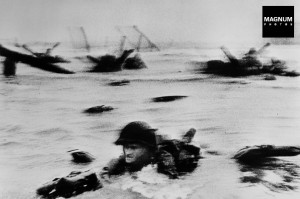Robert Capa
Robert Capa
The above image by Robert Capa is referred to in the OCA course notes as an example of an iconic photograph that captures motion blur. It does that without doubt; however, for want of sounding controversial, I often wonder if it was deliberate. Capa was under heavy fire when this image was taken, D-Day wasn’t a pleasant experience, did he actual have time to consider the slow shutter speed or is this just a happy accident?
Robert Frank
Elevator Girl by Robert Frank Linked image http://www.npr.org/2009/08/30/112389032/robert-franks-elevator-girl-sees-herself-years-later (assessed 17th August 2015) is another image cited for is use of motion blur. This picture whilst again the motion blur could be unintentional has more of a deliberate feel to it than Capa’s, (Capa’s is still a stunning photograph nonetheless) as the girl froze in time, bored in her world, as the rest of the world moves around her.
I am not familiar as whole with Franks work, and I will try at a later date to research the Americans and put together a separate blog post.
Hiroshi Sugimoto
The suggested video https://www.youtube.com/watch?v=rY3nGoZqw9U while fascinating, his images of the movie theatres cause me confusion as while I know there is movement there they do not show it in an obvious way. Is he trying more to how the passage of time or the movement of light? I’m not sure.
Sugimoto does have other images that interest me in other projects, and he is someone I will research further.
Michael Wesley
To say Michaels Wesley has taken the concept of long exposure photography a step further that most would be an understatement.
Using a technique, which remains a secret, using a combination of a large format camera, ND filters, and a pinhole he has captured images with exposures of over several years and says he is capable of making images of up to 40 years.
The images are quite a fascinating as the show the passage of light and time. Linked is an image take in an office over a year back in 1997-1998 http://itchyi.squarespace.com/storage/Michael%20Wesely%2029%20July%201996%20-%2029%20July%201997%20Office%20of%20Helmut%20Friedel.jpg?__SQUARESPACE_CACHEVERSION=1279627342824(assessed 17th August 2015)
While, I’m not very interested in this Wesley’s or Sugimoto’s long-exposure photography looking at them both together Wesley’s images help me with my confusion with Sugimoto theatre Images.
Maarten Vanvolsem
“The paradox of dance photography – how to make something move in a still image – does not seem to have a solution unless one discards the traditional central shutter/snapshot photography. With strip photography, we can focus on the choreography, the transitions, rather than freezing dancers in midair.”http://www.imageandnarrative.be/inarchive/Timeandphotography/vanvolsem.html (assessed 17th August 2015)
To capture this Vanvolsem has used a loving camera, with a moving subject, capturing several images in a single frame; however, personally I do not see what she is trying to convey more that the simple steps movement.
Francesca Woodman
The most powerful use of movement I have seen in the brief research session is in the work of Francesca Woodman.As it suggests in the OCA course notes is hard not to see how perhaps she say herself in the world and the lead up to her suicide at a tragically young age.
The Tate website points that she usually places herself in the frame but are not conventional self –portraits. However, I view this images I see a deeply troubled girl not comfortable in the world, as is suggested the ghostly images add to this feeling.
However, what worries me the most if I did not know she had committed suicide at 22 would I see these same dark images?
http://www.gerrybadger.com/francesca-woodman (accessed 17th August 2015)
http://www.tate.org.uk/art/artists/francesca-woodman-10512 (assessed 17th August 2015)
Christoper Doyle
Finally, Cinematographer Christopher Doyle shot the opening scene to Wong Kar-Wai’s Chungking Express (1994) stand out for me. The additional camera movement and show shutter speed draw your eye around the screen – conveying the desperate panic and disorientation felt in the chase situation. Plus having walked the same alley many times, I know now disorientating they are.

